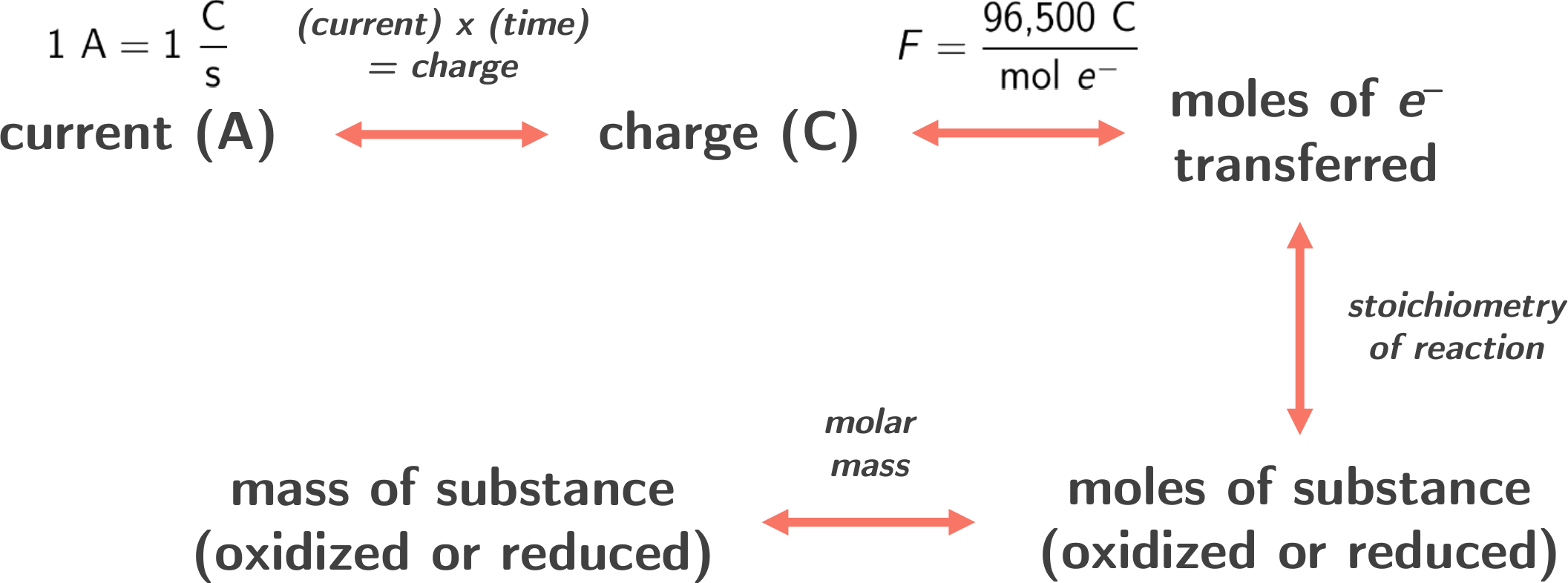8.10 Quantitative Electrochemistry
Quantitative electrochemistry illustrates the relationship between an amount of electricity and the extend of a chemical reaction. The following flowchart outlines this relationship.

Note that current (I) is usually given in units of amperes (A), the SI unit for current. Exactly 1 ampere is equivalent to 1 Coulombs per second (C s–1).
\[1~\mathrm{A} = 1~\mathrm{C~s^{-1}}\]
8.10.1 Example: Current and time to mass
Consider the following redox reaction
\[\mathrm{Ag^{+}}(aq) + e^- \longrightarrow \mathrm{Ag}(s)\]
which occurs in a process called electroplating.
](files/ch17/electroplating-silver.jpg)
Here, silver is dissolved (loses electrons) and then plates the spoon, which acts as the cathode, to form a thin silver layer. Quantitative electrochemistry allows us to determine
- how much silver will precipitate onto the cathode given an amount of current applied over time, or
- how much current applied over time is needed to precipitate a desired amount of silver
Let us consider applying a current of 1.30 A through this electrolytic cell containing silver nitrate for exactly 10 minutes. What mass (in g) of silver will be generated?
Looking at our flowchart above, we are starting with current and time. We will work our way to the end (mass of substance). Be sure to convert time into seconds.
\[\begin{align*} m_{\mathrm{Ag}} = \left ( \dfrac{\mathrm{1.30~C}}{\mathrm{s}} \right ) \left ( \dfrac{\mathrm{600~\mathrm{s}}}{1} \right ) \left ( \dfrac{1~\mathrm{mol}~e^-}{96,485~\mathrm{C}} \right ) \left ( \dfrac{\mathrm{1~\mathrm{mol~Ag}}}{1~\mathrm{mol}~e^-} \right) \left ( \dfrac{107.87~\mathrm{g}}{\mathrm{mol~Ag}} \right ) = 0.87~\mathrm{g~Ag} \end{align*}\]
8.10.2 Example: Current and time to mass
A current of 2.50 A is passed through an electrolytic cell for exactly 1 hour to form aluminium metal from aluminum(III) ions. What mass (in g) of aluminum will be generated?
\[\mathrm{Al}^{3+}(aq) + 3e^- \longrightarrow \mathrm{Al}(s)\]
\[\begin{align*} m_{\mathrm{Al}} = \left ( \dfrac{\mathrm{2.50~C}}{\mathrm{s}} \right ) \left ( \dfrac{\mathrm{3600~\mathrm{s}}}{1} \right ) \left ( \dfrac{1~\mathrm{mol}~e^-}{96,485~\mathrm{C}} \right ) \left ( \dfrac{\mathrm{1~\mathrm{mol~Al}}}{3~\mathrm{mol}~e^-} \right ) \left ( \dfrac{26.98~\mathrm{g}}{\mathrm{mol~Al}} \right ) = 0.84~\mathrm{g~Al} \end{align*}\]
8.10.3 Example: Mass and current to time
A current of 1.86 A is passed through an electrolytic cell to form 8.34 g of Au. How long (in h) is required?
\[\mathrm{Au}(aq) + e^- \longrightarrow \mathrm{Au}(s)\]
\[\begin{align*} t = \left ( \dfrac{8.34~\mathrm{g~Au}}{1} \right ) \left ( \dfrac{\mathrm{mol~Au}}{196.97~\mathrm{g~Au}} \right ) \left ( \dfrac{1~\mathrm{mol}~e^-}{\mathrm{1~\mathrm{mol~Au}}} \right ) \left ( \dfrac{96,485~\mathrm{C}}{1~\mathrm{mol}~e^-} \right ) \left ( \dfrac{\mathrm{s}}{1.86~\mathrm{C}} \right ) \left ( \dfrac{\mathrm{min}}{60~\mathrm{s}} \right ) \left ( \dfrac{\mathrm{h}}{60~\mathrm{min}} \right ) = 0.61~\mathrm{h} \end{align*}\]
8.10.4 Example: Mass and time to current
What current (in A) is required to pass through an electrolytic cell for exactly 1 hour to form 25.00 g of Au?
\[\mathrm{Au}(aq) + e^- \longrightarrow \mathrm{Au}(s)\]
\[\begin{align*} I = \left ( \dfrac{25.00~\mathrm{g~Au}}{1} \right ) \left ( \dfrac{\mathrm{mol~Au}}{196.97~\mathrm{g~Au}} \right ) \left ( \dfrac{1~\mathrm{mol}~e^-}{\mathrm{1~\mathrm{mol~Au}}} \right ) \left ( \dfrac{96,485~\mathrm{C}}{1~\mathrm{mol}~e^-} \right ) \left ( \dfrac{1}{3600~\mathrm{s}} \right ) = 3.40~\mathrm{A} \end{align*}\]